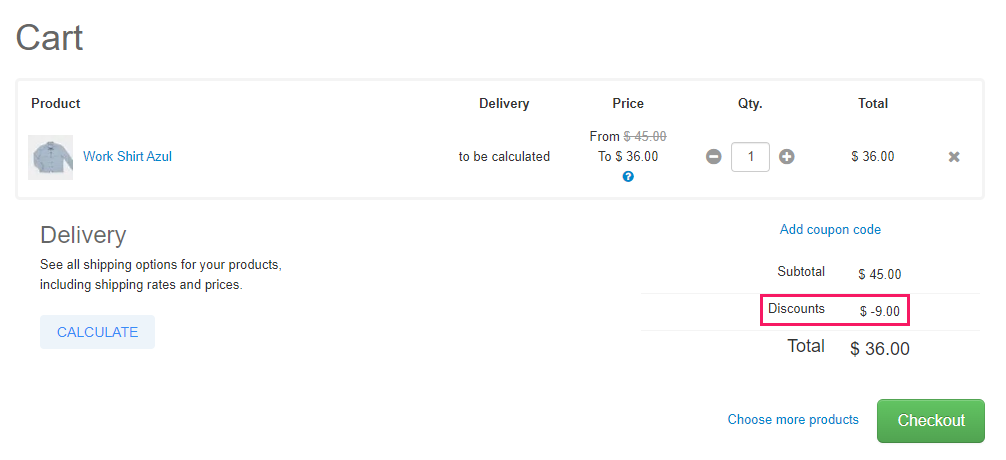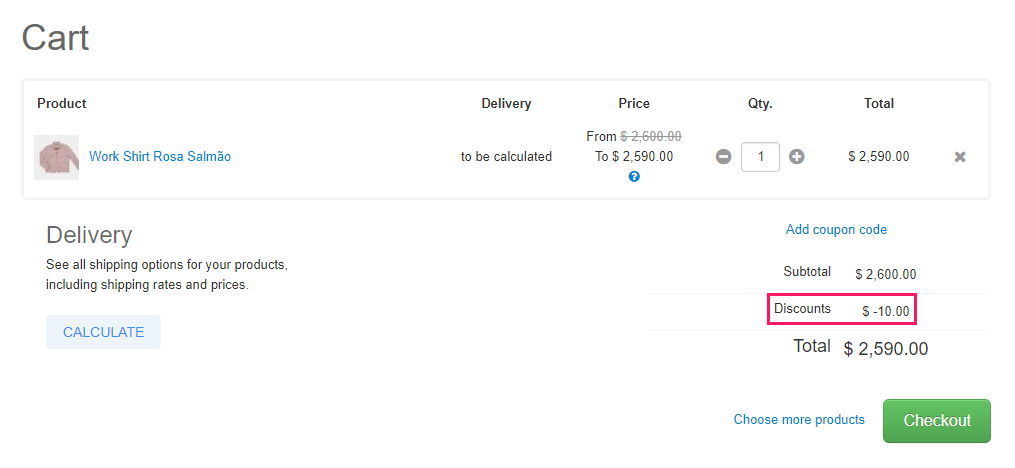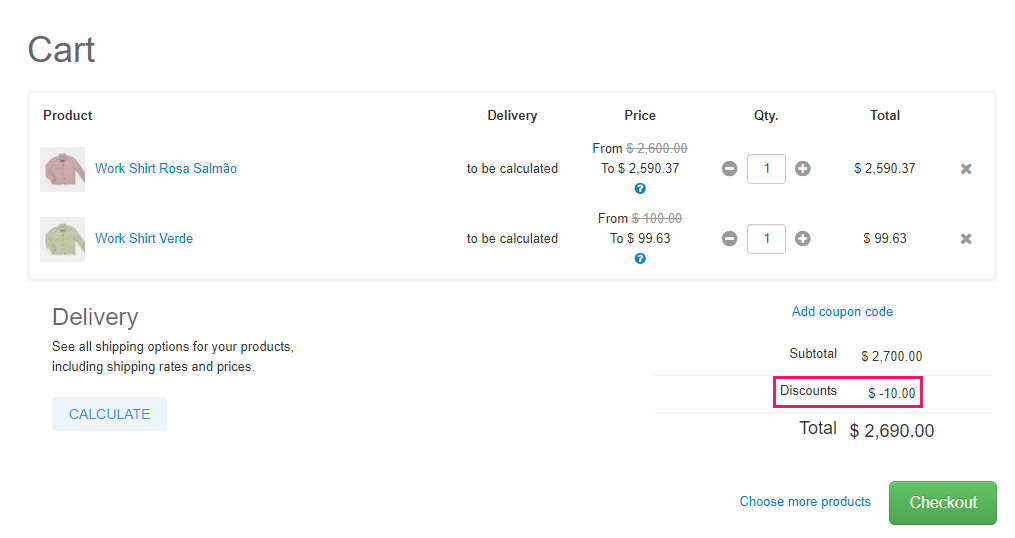When you create a regular promotion in Promotions > Promotions > New promotion > Regular, one of the available options when choosing the discount type and amount is Nominal discount based on formula.
By selecting this type of discount, you need to create a formula defining how the applied discount will be calculated. In this article, we’ll explain how to build a formula which meets your promotion's objectives.
To build your formula, you can use variables such as total, shipping (freight), and quantity, perform operations (addition, subtraction, multiplication, and division) and apply functions such as min, max, and floor.
Variables
To build the formula for your promotion, you can use the variables described below.
| Variable | Description |
|---|---|
total | Sum of the selected product prices. |
freight | Shipping value. The shipping rate used in the formula will be the lowest available for a specific order, regardless of what the customer selects. |
quantity | Total number of all items in the cart. |
Operations
Use the conventional signs in your formula to make mathematical operations.
| Operation | Sign |
|---|---|
| Sum | + |
| Subtraction | - |
| Multiplication | * |
| Division | / |
You can do a multiplication to calculate the desired discount percentage using variables. For example: To apply a 50% discount on the total price of the selected products, the formula would be total * 0.5.
To indicate the order in which calculations should be done, write the calculation which comes first between parenthesis (). For example: If a store wants to apply a 40% discount on the total price of the order plus the shipping cost, the formula must be (total + freight) * 0.4.
You must always use the dot (
.) as a decimal separator.
Functions
You can use the min function to limit the discount value or the max function to prioritize the largest possible discount. The floor function allows you to get the integer part of a value, discarding decimals. See below for more details on how to apply these functions.
When using functions, there must be a space between the function and the opening parenthesis. For example:
min (total * 0.2, 10).
Limiting the discount
If you want to limit the maximum value of the discount, you can use the min function, which returns the lowest value from a set of amounts.
Imagine the following scenario: A store wants to apply a 20% discount, limited to $ 10, on the cart total price.
In this case, the formula must specify that if total * 0.2 is higher than 10, the applied discount will only be 10. To do that, you can structure the formula using the min function as shown below:
min (total * 0.2, 10)
The promotion will apply the lowest discount in each case, comparing the 20% calculation of the total to the limited amount of $ 10. Check out how to apply this promotion in the following scenarios.
Scenario 1
A customer added a $ 45 item to the cart. By calculating 20% of the total price, the result is 9, as per total * 0.2 = 9. Since 9 is below the discount limit value, the applied discount will be $ 9.

Scenario 2
Another customer added a $ 2600 item to the cart. By calculating 20% of this amount, the result is 520, as per total * 0.2 = 520. Since this value is above the limit ($ 10), the discount will be $ 10.

Scenario 3
A third customer added two items to the cart: One costs $ 100 and the other $ 2600. Their sum is $ 2700, as per total = 2700. By calculating 20% of the total amount, the result is 540, according to total * 0.2 = 540. Since this value is above the limit ($ 10), the applied discount will be $ 10.

The total discount of $ 10 is proportionally distributed among the items, based on each item's price and quantity. The platform makes this distribution automatically, as explained below.
First, the total value of the discount ($ 10) is divided by the total value of the items ($ 2700), as follows: 10 / 2700 = 0,0037037.
Next, multiplying 0,0037037 by the value of the first item ($ 100) will return the following result: 0,0037037 * 100 = 0,37037037. Consequently, the amount discounted on the first item will be rounded to $ 0,37. The final price of the first item will be $ 99,63.
Then, multiplying 0,0037037 by the value of the second item will return the following result: 0,0037037 * 2600 = 9,62962962963. Therefore, the amount discounted on the price of the second item will be rounded to $ 9,63. The final price of the second item will be $ 2590,37.
Prioritizing the highest discount possible
To prioritize the highest discount possible, you can use the max function, which returns the highest value from a set of amounts.
Suppose a store wants to make a promotion which applies a 10% discount on the order total price plus the shipping cost, setting a minimum discount of $ 5.
The formula must specify that if (total + freight) * 0.1 is lower than 5, then the applied discount will be 5. Hence, the structure will be the following:
max ((total + freight) * 0.1, 5)
The promotion will apply the highest discount in each case, comparing the minimum value of $ 5 to the calculation of 10% of the order total price plus the shipping cost.
Applying a multiple discount with a rounded-down value
To apply a multiple discount based on a rounded-down value, use the floor function, which rounds the result of a division down to the nearest integer.
For example, in a promotion offering a discount of $10 USD for every $100 USD spent, calculate how many times $100 USD fits into the order total, rounding down. Then, multiply the discount value of $10 USD by the number of complete multiples of $100 USD to determine the discount.
Below is the formula structure for calculating the discount:
floor(total / 100) * 10
This promotion applies the largest possible discount based on the order total, considering only whole multiples of $100 USD. For example, if the order total is $250 USD, the calculation will apply a discount of $20 USD since US$100 fits twice into $250 USD.